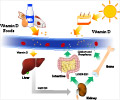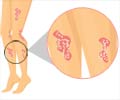- Alaimo K, McDowell MA, Briefel RR, et al. (1994) Dietary intake of vitamins, minerals, and fiber of persons ages 2 months and over in the United States: Third National Health and Nutrition Examination Survey, Phase 1, 1988-91. Adv Data. 14. 1-28.
- Merck manual (2016) Overview of vitamins. In. The Merck Manual of Medical Information
- Russell RM. (2001) Vitamin and trace mineral deficiency and excess. Braunwald E, Fauci A, Kasper D, et al, eds. Harrison's Principles of Internal Medicine. 15th ed. New York, NY: McGraw-Hill; 2001. vol 1: 465-6.
Vitamin Deficiencies Management
Vitamins are essential nutrients for sustaining life and maintaining optimal physiological functions. Vitamin deficiencies are widespread, and the global data suggest that vitamin A, D, and B12 deficiencies are the most prevalent. Pregnant women, children under 5 years of age, geriatric patients with chronic ailments, and malnourished people are at maximum risk of developing a vitamin deficiency. The greatest concern with vitamin deficiency is that it can persist for a generation and thus can have a huge impact not only at a personal level but also at a social level.
Listed below are different forms of vitamin deficiencies, the related symptoms, and available medical management as well as prevention strategies.

Vitamin A (Retinol) Deficiency
Causes of Vitamin A Deficiency:
- Minimal or no consumption of animal liver, seafood, eggs, yellow & green vegetables and fruits, milk products.
- Diseases and conditions like cystic fibrosis, bile duct obstruction, cirrhosis, duodenal bypass, celiac disease, giardiasis, persistent diarrhea, and pancreatic insufficiency which reduce the absorption, storage, and availability of vitamin A and thus cause a deficiency.
Symptoms of Vitamin A Deficiency:
- Earliest symptom of night blindness caused due to Retinal damage.
- Dryness and thickening of conjunctiva and cornea of the eyes (xeropthalmia). The condition is very common in malnourished children.
- Foamy deposits (Bitot spots) in the sclera or the white part of the eye.
- Blindness can occur in under-managed or untreated cases.
- Thickening and stiffening of the outer linings of lungs, intestine, and urinary tract.
- Weak immunity and therefore, recurrent infections, especially in children and infants.
- Hampered growth and development of a child.
- Dry and scaly skin.
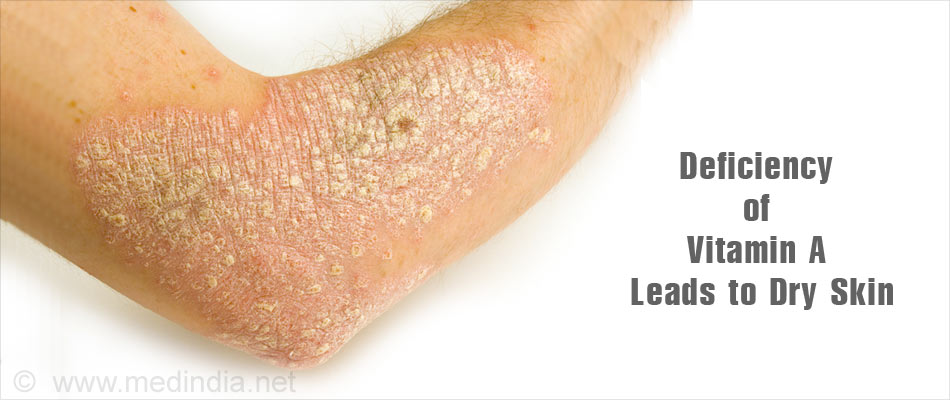
Treatment Using Vitamin A Palmitate:
- For dietary deficiency: Vitamin A palmitate oral supplements, initially 60,000 IU once/day for 2 days followed by 4500 IU once/day.
- For xeropthalmia: Two days oral dosing of 50,000 IU for infants < 6 months, 100,000 IU for infants 6 to 12 months, or 200,000 IU for children > 12 months and adults. The third dose is given after 2 weeks.
- For infants born to HIV-positive mother: 50,000 IU within 48 hours of birth.
- An overdose of vitamin A can cause acute toxicity and thus vitamin A must not be consumed without medical prescription.
Prevention of Vitamin A Deficiency:
- Include dark leafy vegetables along with bright and yellow colored fruits and vegetables like pumpkin, papaya, oranges, and carrots in the daily diet.
- Make sure your diet contains animal liver, seafood, cod liver oil, eggs, and fortified milk products.

Vitamin B1 (Thiamine) Deficiency (Beriberi)
Causes of Thiamine Deficiency:
- Routine diet mainly consisting of refined flour, white sugar, white rice, and highly processed foods.
- In conditions where demand for thiamine increases like hyperthyroidism, extensive exercise routines, fever, pregnancy and lactation.
- Conditions like persistent diarrhea, liver insufficiency, and alcoholism, which reduce absorption and metabolism of thiamine and thus cause the deficiency.
Symptoms of Vitamin B1 Deficiency:
- Early symptoms include loss of appetite, insomnia, sudden weight loss, stomach upset, fatigue, poor memory, and irritability.
- Severe deficiency can lead to beriberi resulting in nerve, heart and brain related abnormalities. Nerve and muscle damage is mainly noted in dry beriberi, whereas heart abnormalities are predominantly noted in wet beriberi.
- Symptoms of Dry Beriberi: Nerve and muscle damage are common symptoms. Patients experience burning and prickling in the palms and toes (which is more severe at night) along with leg cramps and pain. Muscle weakness and wasting are common (muscle atrophy).
- Symptoms of Wet Beriberi: Wet beriberi is associated with heart abnormalities like tachycardia (fast heart rate), heart overload (more blood for the heart to pump out) and blood vessel dilatation. Dilated blood vessels cause warm and sweaty skin. Heart failure is observed on long term which leads to accumulation of fluid in the legs and lungs, which can be life-threatening.
- Brain Abnormalities: Brain abnormalities due to thiamine deficiency are common in alcoholics and may go unnoticed until certain events to worsen thiamine deficiency occur. Thiamine deficiency is worsened due to increased thiamine demand in case of alcoholic binge or when the addict is given intravenous carbohydrate for treating any other condition. The two brain abnormalities observed with thiamine are:
- Wernicke encephalopathy: Major symptoms are involuntary movement of eyes (nystagmus), difficulty in eye movements, difficulty in walking, and confusion. If the condition is not treated effectively, it may lead to coma or even death.
- Korsakoff psychosis: Symptoms include confabulation (memory disturbance), memory loss for recent events, and confusion.
- Symptoms of Infantile Beriberi: Infantile beriberi occurs in newborns of 3-4 weeks whose mothers were deficient in thiamine. This may cause sudden heart failure which can be life-threatening. Also, these infants can lose voice (aphonia) to a certain degree and certain reflexes may be absent on examination.
Treatment of Thiamine Deficiency with Supplemental Thiamine:
- For nerve damage (neuropathy): 10-30mg/day for 2 weeks or till the symptoms disappear.
- For water retention related to wet beriberi: 100 mg IV once/day, until symptoms are resolved.
- For Wernicke-Korsakoff syndrome: 50-100 mg/day via injection into the muscle or vein until symptoms reduce, followed by 10-20 mg once/day oral supplementation until a complete therapeutic response is obtained.
Prevention of Thiamine Deficiency:
- Include whole grains like unpolished rice, bajra, ragi, and whole wheat in your routine diet.
- Consume seeds, nuts, eggs, soy products, legumes, yogurt, cheese on a regular basis. Meat and seafood should be consumed by non-vegetarians.
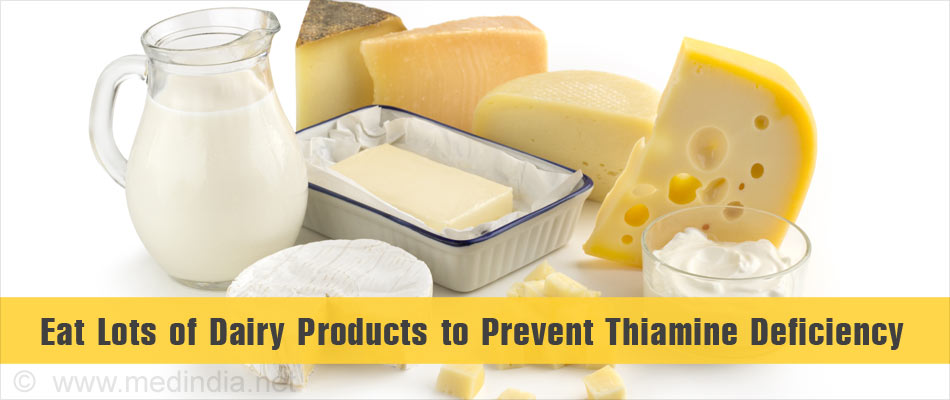
Vitamin B2 (Riboflavin) Deficiency
Causes of Riboflavin Deficiency:
- Insufficient or nil consumption of fortified cereals, milk products, meat, and seafood.
- Patients with persistent diarrhea, dysfunctional liver diseases, undergoing dialysis, using barbiturates for a long duration, and alcoholism.
Symptoms of Vitamin B2 Deficiency:
- Cracking at the corners of the mouth (angular stomatitis) and on the lips (cheilosis) which are very painful.
- On the long term, the cracking turns into fissures, which can get infected with a fungus, Candida albicans.
- Sore mouth and sore tongue along with magenta coloration of the tongue.
- Red, greasy, and scaly patches (seborrheic dermatitis) appear in genital areas, around eyelids, on ears, nose, and the gap between nose and mouth.
Treatment Using Riboflavin Supplements:
- Since riboflavin deficiency usually occurs along with other vitamin deficiencies, the patient must also be treated with other water-soluble vitamin supplements.
- Injections into a muscle are only given in severe cases.
- The dose for oral riboflavin is 5 to 10 mg once a day.
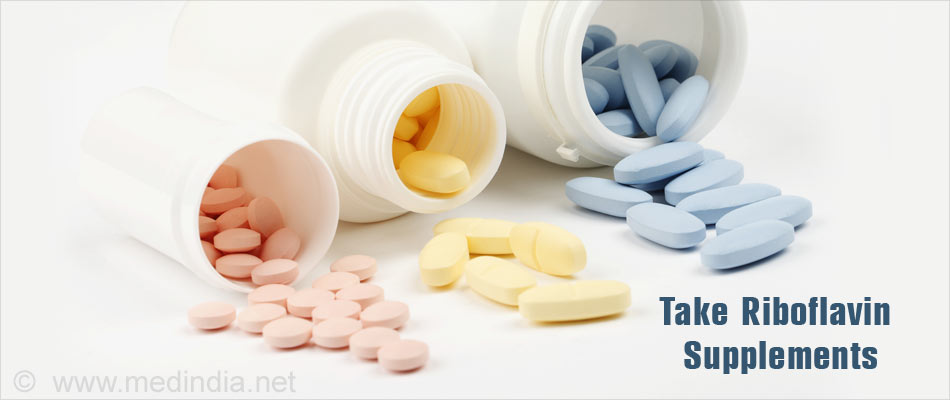
Prevention of Riboflavin Deficiency:
- Include milk and other dairy products.
- Soybean, mushrooms, green leafy vegetables, nuts, and asparagus are rich sources of riboflavin and must be consumed regularly.
- Patients undergoing dialysis must take riboflavin supplementation to prevent deficiency.
Vitamin B3 (Niacin) Deficiency (Pellagra)
Causes of Niacin Deficiency:
- Extensive use of maize as a staple cereal food as it is devoid of both niacin and tryptophan (tryptophan can be converted into niacin by the liver). Pellagra is more prevalent in Central American countries which use alkali processed corn for making tortillas.
- Prolonged diarrhea, liver cirrhosis and alcohol abuse lead to poor niacin absorption and thus cause pellagra.
Symptoms of Vitamin B3 Deficiency:
- Skin symptoms: Dark red and symmetric rashes on the skin exposed to the sun. Rashes on hands appear like gloves (pellagrous gloves), on feet like boots (pellagrous boot), and on the neck like a necklace.
- Mucus membrane symptoms: Niacin deficiency is characterised by redness, swelling, and pain in the mucosal layers of mouth (stomatitis) and tongue (glossitis) along with ulcerations on the inside of the lower lip, below the tongue, and inside the cheeks. Symptoms like redness, edema, pain and ulcers may also be found in vagina and urethra of some patients.
- Gastric symptoms: Mild to moderate deficiency causes burning in the food pipe and throat. Abdominal discomfort, constipation and belching are common. In severe deficiency cases, bloody diarrhea along with nausea and vomiting occur.
- Central Nervous System (CNS) symptoms: In severe deficiency, CNS symptoms like psychosis (serious mental disorder), apathy (lack of interest), insomnia, and fatigue occur. Brain malfunction (encephalopathy) can lead to drastic presentations like memory loss, depression, hallucinations, disorientation, anxiety, and paranoia (anxious or fearful feeling).

Treatment with Nicotinamide:
- A balanced diet including other vitamins, especially riboflavin and pyridoxine is crucial for management.
- Symptoms are treated with 250-500 mg/day nicotinamide orally.
Prevention of Niacin Deficiency:
- Avoid processed tortillas, include almonds and peanuts.
- Animal products like meat and liver are a rich source of niacin. Vegetarians can consume brown rice, unprocessed wheat, tomatoes, potatoes, and mushrooms to avail recommended daily dose of niacin.
Vitamin B6 (Pyridoxine) Deficiency
Causes of Vitamin B6 Deficiency:
- Consuming highly processed foods on a routine basis.
- Routine low protein and low carbohydrate diet.
- Absorption disorders or malabsorption syndromes.
- Chronic alcoholism.
- Chronic use of pyridoxine-inactivating drugs like isoniazid, penicillamine, some anti-seizure medications and hydralazine.
Symptoms of Vitamin B6 Deficiency:
- Pyridoxine deficiency in infants can cause seizures, which do not respond to the treatment with classic anti-seizure medications.
- In adults, pyridoxine deficiency causes pellagra-like symptoms which are characterised by red and painful skin rashes, prickling and burning sensation in palms and feet, sore mouth, redness and pain in the tongue, cracking and fissures on the corners of the mouth and on lips, confusion, depression, and anxiety.
- Chronic deficiency can lead to anemia which is observed as fatigue, disorientation, weakness, and delirium.
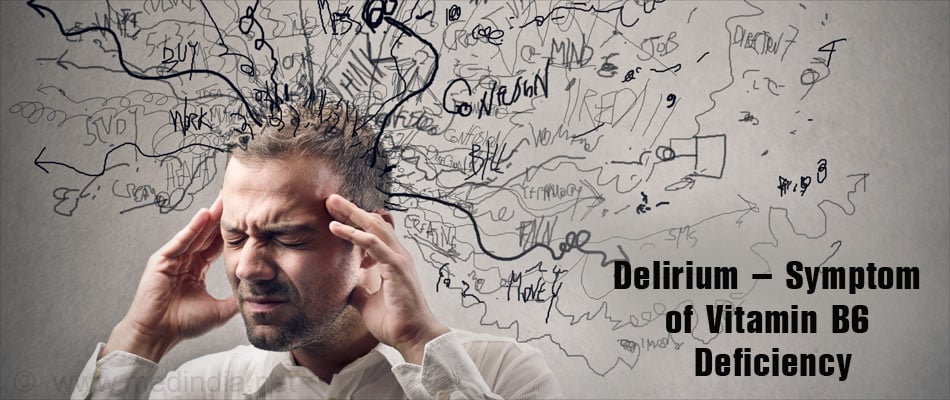
Treatment Using Pyridoxine Supplementation:
- Pyridoxine deficiency in adults is treated with 50-100 mg supplementation once daily.
- Infants are treated with higher doses of pyridoxine according to their general health condition and body mass.
Prevention of Pyridoxine Deficiency:
- Patients taking isoniazid are treated with 30-50 mg pyridoxine once daily to prevent deficiency.
- Non-vegetarians should include animal products like eggs, beef, pork, chicken and seafood.
- Vegetarians should include potatoes, yam, sweet potato, spinach, banana, and other non-citrus fruits in daily diet.
Vitamin B9 (Folate) Deficiency
Causes of Folate Deficiency:
- Inadequate intake of leafy vegetables and citrus fruits.
- Conditions of increased demand like pregnancy and lactation.
- Inadequate absorption in cases of alcoholism, malabsorption diseases, celiac disorder, and prolonged use of medications like folate antagonists and anticonvulsants.
Symptoms of Folate Deficiency:
- Anemia is the most common symptom, which is characterised by fatigue, pale skin, and shortness of breath, irritability and light-headedness.
- Severe cases are observed as redness and pain in the tongue, depression, unreasonable weight loss, and reduced sensation for taste.
- Folate deficiency in pregnant women may lead to spinal or brain abnormalities in the unborn infant.
Treatment with Folate:
- 400 to 1000 ìg folate orally per day for treating deficiency.
- 600 ìg/day orally for pregnant women up to the third month of pregnancy.
- In women with a history of a fetus with neural tube defect (spinal cord defect), 4000 ìg/day folate must be started at least 1 month before conception and the dose must be continued up to the third month of pregnancy.
Prevention of Folate Deficiency:
- Include dark green vegetables like spinach, broccoli, and fenugreek leaves in the routine diet.

- Add dried legumes like chickpeas (chana), pigeon peas (tuvar dal), kidney beans (rajma) and moong in the daily diet.
- Use fortified flours with folic acid.
Vitamin B12 (Cobalamin) Deficiency
Causes of Vitamin B12 Deficiency:
- Vegetarian and vegan people who do not consume animal products, in whom it is most prevalent.
- Due to reduced absorption in conditions like inflammatory bowel disease, pancreatic disorders, celiac disease, bacteria overgrowth in the intestinal tract, tapeworm infestation, regular use of antacids and anti-diabetic medications, bariatric surgery, AIDS, and reduced stomach acidity.
- Intrinsic factor is crucial for absorption of cobalamin in the digestive tract. The absence of intrinsic factor occurs when an autoimmune disease destroys the stomach lining which produces intrinsic factor. Also, surgical removal of stomach lining during bariatric surgery causes vitamin B-12 deficiency.
- Liver disorders, which interfere with storage of cobalamin in the body.
Symptoms of Cobalamin Deficiency:
- Pernicious anemia is the most common symptom of vitamin B12 deficiency. However, slow development of anemia allows the body to physiologically adapt, and therefore only mild to moderate symptoms are observed even if anemia has reached a severe stage.
- Paleness, fatigue, disorientation, and weakness are basic indications of pernicious anemia. In chronic conditions, the patient may experience difficulty in breathing, rapid heart rate, and dizziness.
- Chronic cases of pernicious anemia may lead to spleen and liver enlargement and even stomach cancers in occasional cases.
- Psychological impacts of vitamin B-12 deficiency include depression, impaired mental function, memory loss, confusion, anxiety, paranoid behaviours, and delirium.
- Vitamin B-12 deficiency also damages nerves and shows prominent effects on the legs. Patients feel tingling and numbness in limbs and lose the positioning senses for hands and legs. Muscle weakness may also develop and the patient can experience difficulty in walking.

Treatment with Vitamin B-12 Supplementation:
- In mild cases of deficiency and where no neurological signs are present, the patient is treated with 1000 to 2000 ìg cobalamin orally once daily.
- In severe cases of deficiency, the patient is treated with 1 mg of vitamin B-12, administered intramuscularly for 1-4 times a week on different days, for several weeks. Once blood abnormalities are resolved (as identified by improved reticulocyte count), the patient is treated with 1 mg supplement every month intramuscularly.
- Although blood abnormalities resolve in most cases, neurological symptoms are difficult to treat and in some cases become irreversible. In such cases, vitamin B-12 injections must be continued for life.
- Babies of vegan mothers who do not consume any animal products including milk must be treated with vitamin B-12 supplements from the birth itself.
Prevention of Vitamin B12 Deficiency:
- Animal products like meat, eggs, fish, and poultry are a rich source of vitamin B-12. Routine consumption is advised to prevent deficiency.
- Unfortunately, vegetarians have only milk and milk products as the main source of vitamin B-12. Therefore, daily consumption of low-fat milk, yogurt, cheese, and paneer is a must.
- For vegans, the only dietary source of vitamin B-12 is fortified cereals and fortified soy milk.
- Vegans and vegetarians must get a blood test for vitamin B-12 on a regular basis and must take vitamin B-12 supplementations as prescribed by the physician.
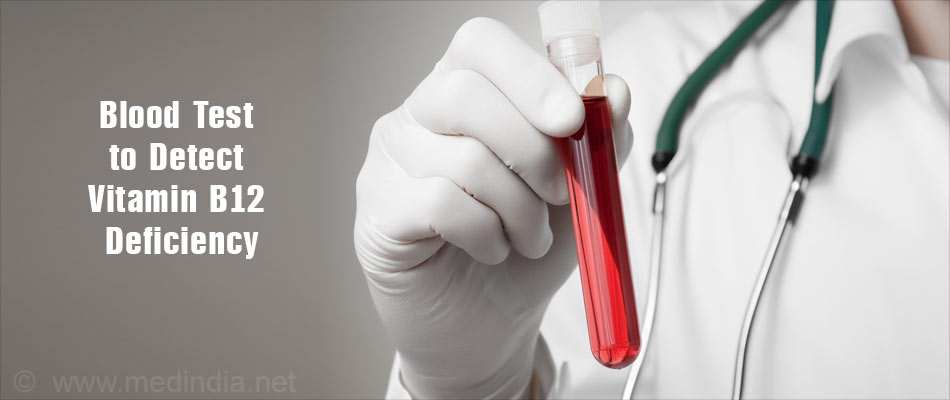
Vitamin C (Ascorbic Acid) Deficiency (Scurvy)
Causes of Vitamin C Deficiency:
- Low or nil intakes of fresh vegetables and citrus fruits.
- In conditions where the requirement for vitamin C increases like iron deficiency, smoking, irritable bowel syndrome, diseases causing fever, hyperthyroidism, surgery, and burns.
- Due to low absorption in conditions like chronic alcoholism and advanced age.
Symptoms of Vitamin C Deficiency:
- Initial symptoms of vitamin C deficiency in adults are weakness, irritability, fatigue, weight loss, joint pain, and muscle pain.
- Untreated deficiency may lead to scurvy which is characterised by swollen, purple and spongy gums, loosened teeth, cuts and bleeding at the corners of the mouth, bruises, dry and scaly skin, dry and brittle hair, and bleeding around hair follicles. Other manifestations are anemia, delayed wound healing, and frequent infections.
- Scurvy in infants leads to loss of appetite, body pain, impaired weight gain, impaired bone growth, anemia, and irritability.
Treatment with Ascorbic Acid:
- For adults, a dose of 100-500 mg ascorbic acid three times a day is prescribed for 2 weeks or until the signs disappear. Treatment is followed by diet modification.
- For infants, treatment is decided by the pediatrician and is accompanied by an improved diet, which consists of breastfeeding and fortified formulas.
Prevention of Vitamin C Deficiency:
- Citrus fruits like lemon, oranges, amla (Indian gooseberry), and lime, while non-citrus fruits like papaya, kiwi, pineapple, and strawberries are excellent sources of vitamin C. Daily consumption is recommended.

- Vegetables like bell peppers, broccoli, cauliflower, cabbage, and chillies are good sources and thus, must be included regularly in the diet.
- Smokers must take 100-120 mg supplement per day on a regular basis to prevent deficiency.
- Pregnant and lactating mothers must take supplements as per the advice of a physician.
Vitamin D Deficiency
Causes of Vitamin D Deficiency:
- Inadequate exposure to the sunlight due to age-related confinement and covering face and limbs by cloth, gloves.
- Malabsorption of vitamin D from the digestive tract.
- Inadequate metabolism in conditions like kidney disorders, liver dysfunction, hereditary type-1 and type-2 vitamin D-dependent rickets, and hereditary hypophosphatemia (low phosphate levels in the blood).
Symptoms of Vitamin D Deficiency:
- Vitamin D is necessary for the formation of strong bones. Vitamin D deficiency may lead to osteomalacia in adults and rickets in children.
- Osteomalacia is characterised by muscle and bone pain, weakness, and weak spine, pelvis, and leg bones. Bone fractures even with minor jarring or mild trauma.
- Rickets is characterised by muscle spasm, soft skull, delayed closing of skull bones, delayed crawling, delayed sitting, and abnormal growth in infants. Abnormal curvature of spine, bowlegs, or knock-knees along with pain is observed in children of 1 year or more. In adolescent girls, vitamin D deficiency leads to flattening of pelvic bones which leads to narrowed birth canal and difficult natural childbirth in later years.
- Deficiency in pregnant mothers causes tetany in infants which manifests as abnormal tingling and prickling (paraesthesia) in fingers, lips, and tongue. Abnormal spasm of hand, feet, and facial muscles can also be seen. In severe cases, seizures can result.
Treatment Using Vitamin D3 Supplementation:
- Osteomalacia and uncomplicated rickets: The patient is first treated for calcium and phosphate deficiency by diet modification or supplementation. The patient is then treated with oral vitamin D3 40 ìg (1600 IU) once/day. After 1 month when enough calcium and phosphate deposition is confirmed using imaging techniques, the dose of vitamin D3 is reduced to 15 ìg (600 IU) once/day taken orally. Geriatric patients may require even higher maintenance dose.
- Tetany is treated with adequate dose (as per the infant’s body mass) of vitamin D3 along with the intravenous injection of calcium salts for 1 week.
- Patients with other conditions like kidney disorder or hereditary rickets are treated with vitamin D3 after extensive endocrinological evaluations and assessment of concurrent diseases.
Prevention of Vitamin D Deficiency:
- Dietary counseling is very crucial for the communities having low exposure to the sunlight Fortified whole wheat flour and cooking with fortified oil have been observed as an effective preventive measure for people who stay out of the sun.
- Dietary sources of vitamin D are fish, cod-liver oil, eggs, cheese, milk and yogurt. Daily consumption is recommended.
- Infants relying only on breastfeeding must be given vitamin D supplementation.

Vitamin E (Tocopherol) Deficiency
Causes of Vitamin E Deficiency:
- Impaired absorption in conditions like a liver disease, cystic fibrosis, pancreatitis, the genetic absence of apolipoprotein B (Bassen-Knornzweig syndrome), and bowel disorder.
Symptoms of Vitamin E Deficiency:
- Infants who do not have adequate stores of vitamin E and are deficient have a major risk of developing hemolytic anemia. In this condition, blood cells rupture leading to bleeding in different regions of the body including the brain thus hampering the normal growth of the baby.
- Neurological manifestations of vitamin E deficiency in children are muscle weakness, drooping eyelid, difficult eye movements, slow reflexes, loss of coordination, problematic walking, and reduced sensation of position (a child might not be able to locate hands or legs without looking at them).
- Symptoms in adults are very rare as they have vitamin E stored in their fat tissues (adipose tissues).
Treatment Using á-tocopherol or Mixed Tocopherols (á-, â-, and ã-tocopherols):
- Deficiency due to malabsorption is treated with oral á-tocopherol 15 to 25 mg/kg once per day OR 200-400 IU mixed tocopherol once daily.
- Large doses of injectable á-tocopherol are administered in severe cases of deficiency to prevent nerve, eyes, and muscle damage.
- Dietary sources of vitamin E are nuts, dark leafy vegetables, and plant oils like sunflower oil, olive oil, vegetable oil, and soybean oil, fish, broccoli, cauliflower, and pumpkin. Routine use of these foods is recommended.
Vitamin K Deficiency
Causes of Vitamin K Deficiency:
- Infants are prone to developing vitamin K deficiency since they have no storage, very less vitamin K is passed through the placenta to the neonates; breast milk is very low in vitamin K, and the infants’ gut lacks the bacteria, which produce vitamin K in the body.
- Since vitamin K is a fat-soluble vitamin, vitamin K deficiency in adults is caused due to very low-fat diet, fat malabsorption conditions like blocked bile duct and cystic fibrosis, and use of drugs like anti-seizure medications and certain antibiotics.
Symptoms of Vitamin K Deficiency:
- Since vitamin K is required for clotting of blood, the main symptom of vitamin K deficiency is bleeding. Bleeding occurs beneath the skin causing bruising; bleeding occurs from the nose, and inside stomach and intestinal lining. Bleeding inside GI and urinary tracts lead to vomiting with blood and blood in stool, and urine respectively. Bleeding from cuts and wounds don’t stop easily.
- Bleeding inside the brain can be life-threatening.
- Vitamin K deficiency also weakens bones.

Treatment with Phytonadione:
- Adults with vitamin K deficiency are treated with 1-20 mg once/day of phytonadione oral or subcutaneous supplementation, depending on the symptoms.
- Infants are treated with 1 mg once/day of phytonadione given subcutaneously or intramuscularly.
Prevention of Vitamin K Deficiency:
- Phytonadione intramuscular injection of 0.5 to 1 mg is advised for all newborns within 6 hours of birth to prevent the incidences of bleeding following birth trauma.
- Phytonadione 10 mg once a day orally is recommended for pregnant mothers who take anti-seizure medications.
- Breastfeeding mothers must increase their dietary intake to reduce chances of deficiency in infants.
- Dietary sources of vitamin K are green leafy vegetables, broccoli, cauliflower, cabbage, meat, fish, eggs, and fortified cereals.



